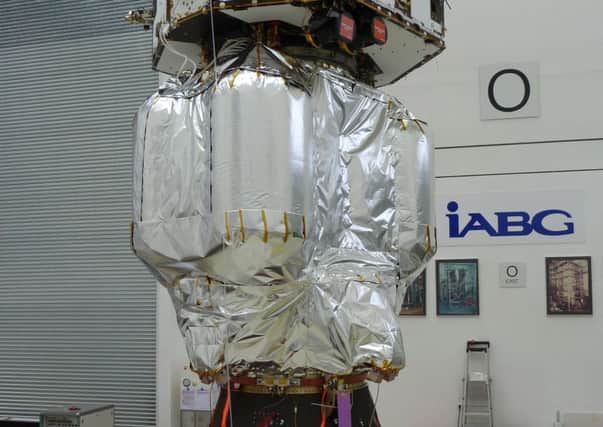Scots university in £294m space mission blast-off


After a decade of painstaking work, a team of Scottish scientists are preparing for the final countdown in their attempt to identify ripples in the space time continuum which can be traced back to the origins of life as we know it.
The cutting-edge LISA Pathfinder craft, in part developed by the University of Glasgow, is en route to the north-east coast of South America ahead of its journey into space this autumn.
Advertisement
Hide AdAdvertisement
Hide AdOnce in orbit, the mission, a flagship initiative by the European Space Agency (ESA), will see the craft travel 1.5 million kilometres from earth, where it will use highly sensitive detectors built by the university’s school of physics and astronomy to explore the unknown.
The findings could change the way we understand physics and gravity and ultimately provide the first direct evidence of gravitational waves created by extremely violent cosmic events such as colliding black holes and the explosion of dying stars.
Gravitational waves, which were predicted by Einstein in 1916 in his general theory of relativity, are theorised ripples in space time comparable with sound waves. Tracing them might make it possible to establish a connection with the Big Bang.
Although the pathfinder itself is not setting out to find evidence of these waves, its technology is key to creating a new space observatory that could identify them in the future.
For the scientists who have worked on the £294m mission, the prospect of making a breakthrough is tantalisingly close.
Paul McNamara, a graduate of the University of Glasgow who now works as the mission’s project scientist with the ESA, said: “This is an extremely challenging mission that will pave the way for future space-based projects to observe gravitational waves, opening a new window to explore the cosmos.”
The astrophysicist added: “We’ve made great progress with LISA Pathfinder in the past decade and are very excited to be so close to operating this incredible physics laboratory in space.”
The pathfinder has passed all its final tests and began its final earthbound journey on Thursday when it was shipped off from an ESA facility to Munich, bound for a spaceport in Kourou, French Guiana.
Advertisement
Hide AdAdvertisement
Hide AdIn November, the spacecraft will set off from earth atop a Vega rocket, an expendable launch system developed by the Italian Space Agency and the ESA.
The payload of the pathfinder contains two floating gold and platinum cubes that, ideally, will move completely free of any disturbances, free from the earth’s vibrational interference in the vacuum of space.
A laser system monitors the separation between them with exquisite precision, looking for telltale movements caused by any tiny stray forces.
The novel metrology system, called a laser interferometer, was developed by Dr Harry Ward and his colleagues in Glasgow. It can detect distance changes as small as ten picometres, or one hundred millionth of a millimetre.
Ward, a reader at the university’s institute for gravitational research, said the Scottish members of the team were excited ahead of the craft’s blast- off.
“The wait is nearly over. After an immense amount of hard work, the first major step towards spaceborne gravitational wave astronomy is about to take place,” he said.
“It’s a tremendously exciting achievement and we’re pleased and proud to have been involved from the start.”